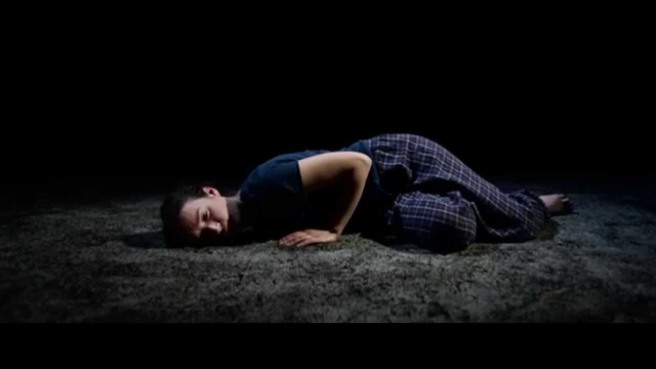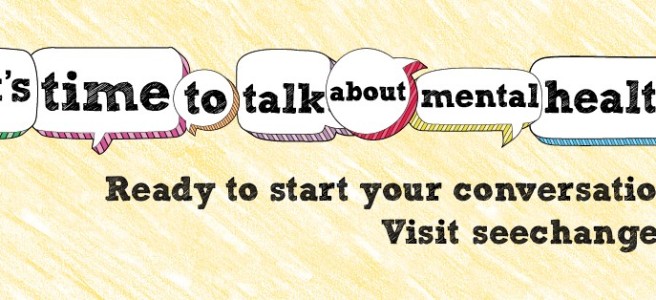This month in Ireland is ‘Green Ribbon Campaign’, one of them cosmetic marketing campaigns that state departments channel millions of euro into in order to create a nationwide perception that your government is being proactive. The ‘Green Ribbon Campaign’ is rolling out over May 2017 and has over 90 Partner Organisations, as much of these campaigns do. ‘See Change: The National Stigma Reduction Partnership’ is the main organiser of the event, and its chief goal, as the name testifies to with its nice double entendre, inviting us both to ‘see change’ and on its idiomatic flipside of ‘sea change’, to bring forth a broad transformation.
A broad transformation in what?
Of mental health of course. Telling us to be aware of it. Giving us advice like, “Don’t just talk about mental health: Just be yourself, chat about everyday things as well.” This may be excellent advice but it’s very difficult to articulate any criticism of such programmes without coming across as facetious, or worse, even callous.
To be honest, despite starting this article with the intention of looking at the ‘Green Ribbon Campaign’ and its worthy goal of breaking down stigmas, it’s hard not to get the feeling that its campaign has the wrong target audience.
Really it’s not the Irish public that has been stigmatising people with mental health problems, it has, since its conception, been the Irish state through the societal discourse it has promoted. A brief flick through countless works of Irish literature highlights the constant trauma, of what Francie Brady in The Butcher Boy calls ‘the garage’. The ‘garage’, the austere, grey walled psychiatric units that overlooked provincial towns, suburbs and city outskirts all around Ireland lurks in the shadows of Irish literature because it lives through the Irish psyche.
The place where you went “to get fixed.”

In Mary Raftery’s documentary, ‘Behind The Walls’, she opens up the film with a statement that shocks one to the quick, because of the very endemicity of the problem: Ireland during the middle decades of the 20th century had more people than any other country in the world, per capita, in mental hospitals putting even the Soviet Union to shame.
Just what could be wrong with all of them?
What Ireland was struggling with then, as it is increasingly again suffering with now, is what it is permissible to be. Ireland in the middle of the last century was a grim place. Briefly, like so many other nations coming out of colonialism there were number of problems to be dealt with. The problem of authority was huge, or to frame that in another way, now that the foreigner who has enslaved me has gone, who now is my master.
Culture was another massive problem, or its lack. Censorship was rampant with any new ideas, literature or art that sought some way of navigating the cultural sterility and rampant authoritarianism of this new Ireland not even making it to a domestic printing press.
With the Irish language also gone and with it dying a relationship to the landscape, to a tradition that preceded the Saxons, this fed into the problem of authority. No erstwhile tradition existed that people in Ireland could identify with, other than what was left in the wake of its demise, the Roman Catholic Church and an Irish nationalism, the Ying to British Nationalism’s Yang.
How did the burgeoning Irish state deal with this problem of authority, of a lack of conviction of even in its own authority to govern? By shifting so much of the authorial decision making to the Catholic Church of course, to justify the existence of a new state. And the only manner in which the Catholic Church could justify its own sinister rule was to ensure that there were all manner of devout Catholics trotting through the streets, schools, aisles, football pitches, civic offices, hospital boards, doctor offices, councils, and so on and that each of these replicated their devoutness for public consumption.
Imagine the immense social pressure that existed in this Ireland, to behave according to a certain ideal of what one ought to be, to repress one’s desire to think, to act, to be, and the mental strain that this had. Still has.
What exactly was wrong then with all these individuals incarcerated in Ireland’s gulags across the land? This is not even to mention those incarcerated in Magdalene Laundries and the other Mother and Baby Homes in existence. When a state deems it necessary to incarcerate such a vast swathe of its people in various institutions, we are not dealing with a mental health problem, we aren’t even dealing with a social problem. We are dealing with a political problem.
Before going any further, it might be worthwhile questioning how do we conceive of politics?
Politics, in Hannah Arendt’s conception of it, is preceded by the need for a public space to exist, a space in which people with an interest in public life come together to make a decision on the collective community. Now in a republic such as what we occupy, where every citizen is supposedly giving a right to participate in politics due to their having the vote, politics for Arendt is absent. Without civic engagement i.e. without a community’s active participation in the creation of the collective realm, without debate, interest, and the collective deliberation that goes along with it, we are being devoid of a political realm.
What we are instead given is the political spectacle. Just cast one’s eye across the pond for a moment and look at May’s refusal to debate Corbyn on national television. Look at Enda Kenny’s refusal to go on live television debates last year for the 2016 General Election. What is being left in the wake of the gradual diminishment of the spaces of civic participation is simply authoritarianism. It follows only the bureaucratic blueprint of how society ought to operate by the map bequeathed to it by the ruling classes and is realised through the bureaucratic apparatuses that wield the will of the state.
How exactly is this a political problem?
We all desire to be part of the world, to make decisions on the space around us, to come together to make decisions on how we want to shape it. By being denied this ability to engage with the world around us, we are denied not just the world but access to our own happiness. When the realisation of the reality that we are exiles to this world, that our own desires have no worth, hope is eradicated. If the only way we can “live” is through sacrificing our desire to live in the world, repressing it so we can participate in the spectacle of life.
Censorship provided the means of this spectacles immersion in Irish soil. It was akin to throwing salt on the cultural development of the new state, forbidding any new ideas being formulated and practiced upon, to shape a political climate that had little authority and furthermore labelling those that engaged in/consumed/ or practiced the art of thinking as transgressor.
The weird thing about comic books in Francie Brady is that they gave our boy not only another way of looking at himself in the world, but made that world possible. His transgressive impulses, the boundaries of which were set by the community’s stigma, could be articulated outside of the community’s discourse of saints and sinners, creating an imaginary space where Francie Brady could survive the armageddon of a community’s judgement on his self worth.
What I’m saying in a pretty perverse sense, is that culture is necessary for the soul’s survival. Self worth in an age where the self is expected to be and have everything, can be given new routes to navigate such bullshit if it is exposed to some sense of the past.
In ‘A Girl is a Half Formed Thing’, what is evident is the lack of culture. Girl is given no cultural choice that existed for a young person to negotiate a sense of self. When there is only one identity for the taking i.e. devout Roman Catholicism, the rebel/ outsider takes the extreme negativity aspects of what is expected them, and articulates their self in this way. Such is what happens to ‘Girl’.
“On my knees I learn plenty – there’s a lot I’ll do and they are all shame when they think their flesh desired. Offer up to me and disconcerted by my lack of saying no. Saying yes is the best of powers. It’s no big thing the things they do.”

Does social stigma arrive out of the ether, that people breathe it like oxygen and all of a sudden have this hypocritical attitude or that hypocritical attitude? All the evidence of the history of this state points to stigma being a social construct, that may yes have had some roots in social values but was actively inflamed through the apparatus’ of the state.
An access to culture, as Guy Debord argues in The Society of the Spectacle is to have access to a history, to become aware of one’s coming to understand oneself in relation to a history that has its basis in a political economy.
“Once there was history, but ‘there is no longer any history’ – because the class owners of the economy, who cannot break with economic history, must repress any other use of irreversible time as representing an immediate threat to itself. The ruling class, made up of specialists in the ownership of things who for that very reason are themselves owned by things, is obliged to tie its fate to the maintenance of a reified history and to the permanent preservation of a new historical immobility.”
What is Debord on about here and what has this got to do with The Green Ribbon campaign I observed on a billboard at a train station one week ago?
To have access to a culture is to have access to the materiality of time. When one thinks about Conservatism, what is most manifest is the preservation of a culture, of the passing down of property, titles, heirlooms, a genealogy and power. Conservatism, which in essence is a constant looking back, validates its culture because it has a lineage that is celebrated, not just by those that directly benefit from it in a material form, but because others rejoice in its history.
Conservatism, like the Catholic Church, have a monopoly over how people access history, how they come to understand themselves as subject. By holding onto that knowledge, usually through institutions like universities etc. the present can not emerge and the weight of the repressed present is worn like a ballast around the neck of the exiled individuals.
Countless works of Irish literature deal with depression and mental illness because it was and is the de facto state of a major proportion of its population. When such campaigns like the Green Ribbon Campaign are run, with an emphasis on individuals wearing a green ribbon and talking to one another, the State is once again pulling off a massive wink and nod, stating that indeed, finally, mental health is a massive issue in this state while not first looking at itself, at the institutional environment that allows it to flourish.
The most glaring example of the of ‘The National Stigma Reduction Partnership’ was last week when it was revealed that a young woman committed suicide, days after her arrest by An Garda Siochana. What could have pointed to a definite ‘sea change’ in tackling the stigmatisation of mental illness in Ireland, of a criticism of the utter lack of awareness of the Gardai in dealing with mental illness, of the lack of care that this individual received and finally that a member of the Garda Siochana shared a video of her online at the height of her mental distress shows the utter ineptitude of a state campaign to tackle stigma.
Because stigma is necessary for state authority. And stigma is only toppled by those that are not afraid to make their voices heard. Though again there is naught but silence, even from a partnership of over 90 partner organisations telling us to wear a green ribbon and talk.

